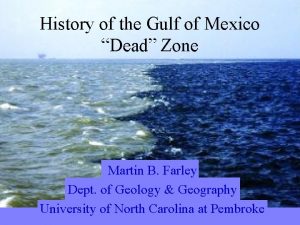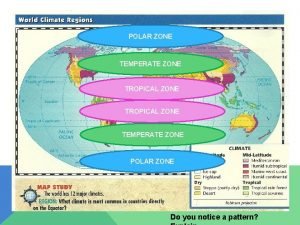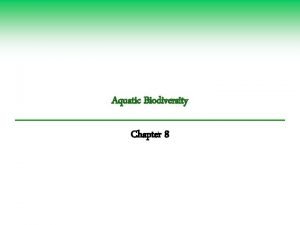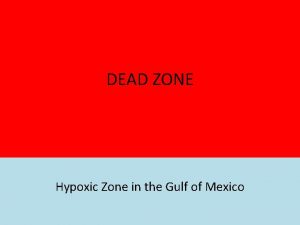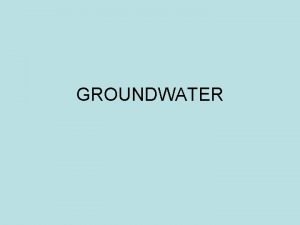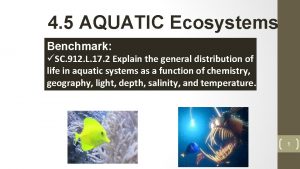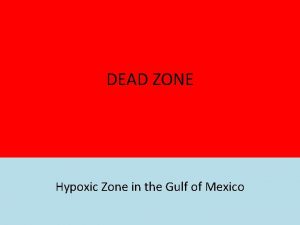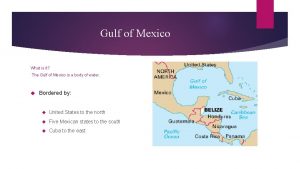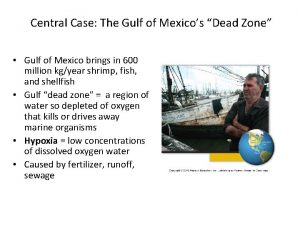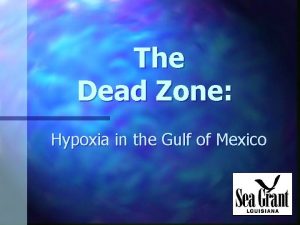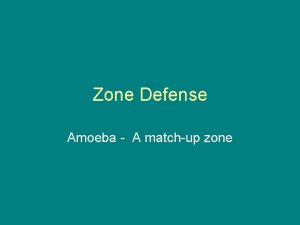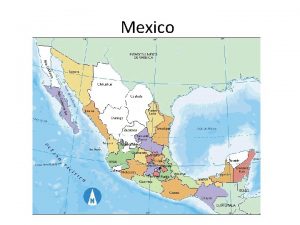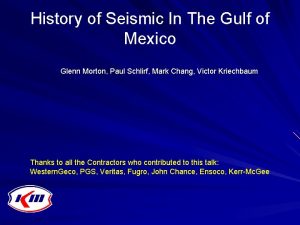History of the Gulf of Mexico Dead Zone




















- Slides: 20

History of the Gulf of Mexico “Dead” Zone Martin B. Farley Dept. of Geology & Geography University of North Carolina at Pembroke

Introduction Audience: Paleontology Undergraduates An Overarching Objective: Historical Perspective (has this been going on all along? )

Major Objectives Applying Deep Time method to “Shallow Time” How Fossils can be Paleoenvironmental Indicators Interpret Change over Time Evaluation of Anthropogenic Cause for Modern Hypoxia

Student Background

Location and Cores Gravity Core at each location plus Box Core at MRD 05 -04

Nature of Data Benthic Foram Abundances at 1 cm intervals (gravity cores 1. 5 -2. 4 m; box core 40 cm) Radiocarbon ages at base of two gravity cores (~ 1000 yrs) Lead-210 for box core

Forams for Hypoxia Estimation Degree of anoxia estimated from percentage of low-oxygen tolerant benthics (PEB index) : Protononion atlanticum Epistominella vitrea Buliminella morgani

Initial Student Tasks Calculate PEB index for each core Graph data depth increases down create graphs with similar depth ranges and PEB ranges for ease of comparison

Sample Data File Calculated Fields

Student Questions Interpret PEB index for each cores, relate to location What does the foram record say about the “dead zone” over the last 1000 years? What context does this give for hypoxia over the last few decades? Can you identify a candidate for the anoxia associated with the 1927 Mississippi flood?

PEB Index Depth (cm) MRD 05 -6 Gravity Core

PEB Index Depth (cm) PE 0305 -1 Gravity Core

PEB Index Depth (cm) MRD 05 -4 Gravity Core

MRD 05 -4 Box Core Depth (cm) PEB Index Plotted at same depth scale as other cores

MRD 05 -4 Box Core Plot Expanded for detail

Rough Interpretations MRD 05 -6, outside the modern hypoxia zone, has low PEB PE 0305, on edge of modern hypoxia, has spikes in PEB index with increase in shallowest 15 cm The MRD 05 -04 cores are within the modern hypoxia zone: Longer core--low PEB indexes at bottom, spikes upward; striking increase in shallowest 25 cm Box core -- striking increase in the shallowest 17 cm Data indicate increase in low-oxygen intensity in youngest record.

1927 Flood

MRD 05 -4 Box Core Candidate for 1927 Flood

Flood—Other Cores

 Gulf of mexico history
Gulf of mexico history Contoh gulf of evaluation and gulf of execution
Contoh gulf of evaluation and gulf of execution Polar tropical and temperate zones
Polar tropical and temperate zones Intertidal ocean zone
Intertidal ocean zone Source zone transition zone and floodplain zone
Source zone transition zone and floodplain zone Oil spill
Oil spill Gulf of mexico pipeline rupture
Gulf of mexico pipeline rupture Deepwater horizon incident
Deepwater horizon incident Meteorological symbols for four types of fronts
Meteorological symbols for four types of fronts Ocean currents gulf of mexico
Ocean currents gulf of mexico Juan soriano la niña muerta; the dead girl; dead infant
Juan soriano la niña muerta; the dead girl; dead infant Bbc learning zone dead sea scrolls
Bbc learning zone dead sea scrolls Dead zone
Dead zone Stretched nostrils
Stretched nostrils What is the conducting zone of the respiratory system
What is the conducting zone of the respiratory system Zone chaude zone froide supermarché
Zone chaude zone froide supermarché Water table chart
Water table chart Zone of aeration and zone of saturation
Zone of aeration and zone of saturation Climate latitude
Climate latitude Photic zone and aphotic zone venn diagram
Photic zone and aphotic zone venn diagram Minute ventilation normal
Minute ventilation normal
